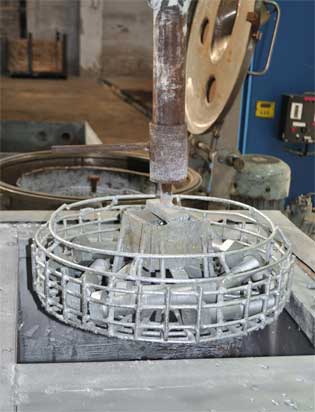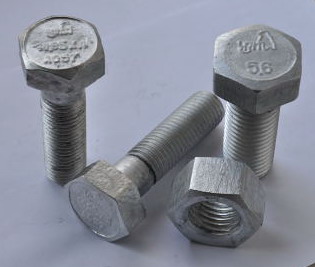
Under the influence of aggressive environmental factors, metal products are subject to corrosion processes, which leads to a decrease in strength and, as a result, an increase in the risk of their destruction. Manufacturers of metal products are constantly improving methods and approaches to anti-corrosion protection of hardware.
Hot-dip galvanizing – is the most effective method of protecting fasteners from corrosion. A solid, rough coating from silver-gray to dark gray is formed by means of immersion of products in a bath with molten zinc, exposure to a certain time and extraction from the melt.
The adhesion of the zinc layer to the surface of metal products is achieved as a result of a diffusion process between molten zinc and iron. The coating usually consists of layers of iron-zinc alloys with a decreasing iron content as they approach the surface. The outer layer is a layer of almost pure zinc with an iron content of 0.007%.
In general, the hot-dip galvanizing process includes the following operations of the technological cycle

- Preparation. Loading of metal products into cassettes with subsequent installation on mobile suspensions.
- Degreasing. Removal of grease stains and foreign contaminants (chips, dust, etc.) from the surface of products by chemical treatment in alkaline solutions.
- Flushing. Washing off solid metal particles with water from the surface of the galvanized products and preventing the transfer of the degreasing solution to subsequent baths.
- Etching. Removal of rust and scale residues from the surfaces of products, as well as chemical activation of the surface of metal products (removal of the oxide film) without damaging it.
- Flushing. Washing off the remains of the pickling solution and iron salts with water.
- Fluxing. It is carried out in order to remove salts and metal oxides from the surface of the galvanized product and to improve the wetting of the surface of the product with molten zinc. A mixture of ammonium chloride and zinc chloride salts is used as a flux during galvanizing in the melt. This is the final stage of surface preparation, which is necessary for applying a protective layer to the surface of the coated metal products.
- Drying. Placing the fluxed products in a drying chamber for uniform drying of the flux. The products are heated to a temperature of 100-120 ° C. At the same time, the products are heated, which facilitates the heating of the galvanizing bath. In addition, the resulting dense film protects the surface of the product from oxidation.
- Hot-dip galvanizing. The formation of a zinc coating is due to the reaction between the surface of the metal and zinc, which together form an alloy. The temperature of the molten zinc is about 450 °C.
- Cooling. After unloading the products from the galvanizing bath, they are air cooled.
- Quality control. Quality control of zinc coating. It is carried out in accordance with GOST 9.307-89 "Hot zinc coatings" by visual and instrument methods.


